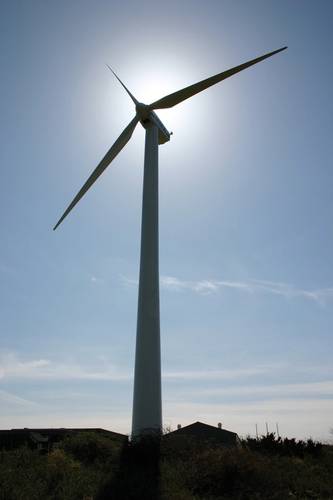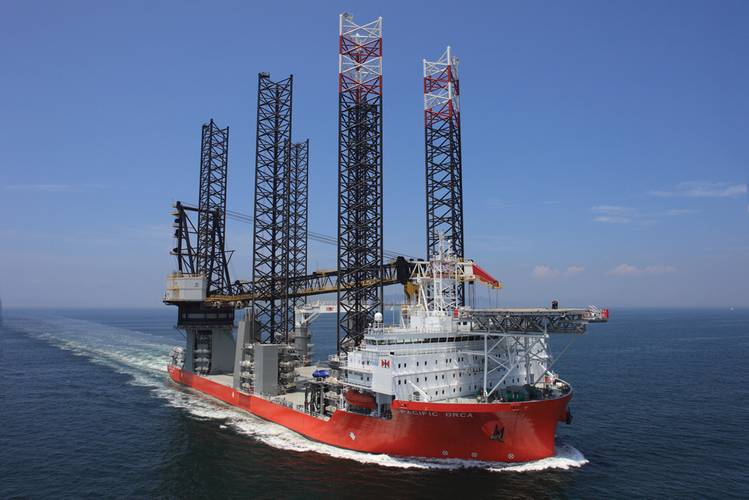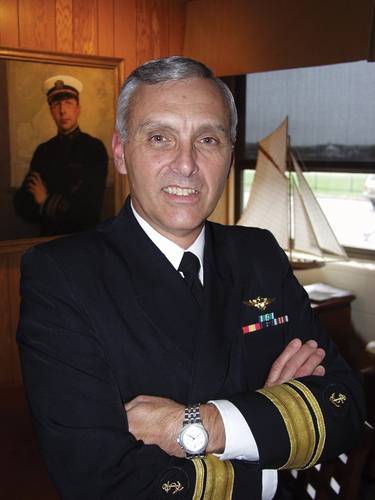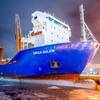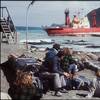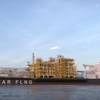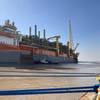Gearing Up For U.S. Offshore Wind Power
Next year, developers hope to start building offshore wind turbines in the U.S., which is already a leader in on-land wind generation. As turbines spin off the coast in a dozen other countries, particularly the UK, Denmark, the Netherlands and Germany, global offshore wind capacity has expanded nearly six-fold since 2006. Most of these installations are in shallow water though winds are stronger out further.
If the U.S. is to have offshore turbines, many residents want them distant enough so they can’t be seen or heard. And environmentalists hope wind farms won’t interfere with birds and marine life. The latter domestic variables, along with making the price of offshore power competitive with traditional shore-based power sources, have slowed the birth of offshore wind here at home. That situation could be changing very soon and some U.S.-based firms are already in the game.
Louisiana-Built Vessel Installed UK Turbines
U.S. companies have been supplying vessels for offshore wind in other nations. Semco LLC in Lafitte, La., got involved awhile ago. Allen Moore, general manager at Semco, said last month “we finished building the 280-foot, KS Titan 2 in 2009, and it set up 35 to 40 wind turbine units on England’s east coast in 2009 to 2010.”
“Titan 2 has 280-foot legs and can work in depths of 220 feet,” he said. “Its large deck space, leg length and dual 200-ton cranes were assets in developing the turbine farm. Our associate company, Seatrax in Houston, designed the cranes that are on mounted legs to create more working deck area.”
Moore continued “Titan 2 can place wind towers in subsea soil, lift the towers and install blades. It’s pretty well self-contained and works autonomously, with its own propulsion cranes and deck storage area. It has living quarters for a crew of fifty.”
He said Titan 2, owned by KS Energy in Singapore, is now working off the West African coast in the oil and gas industry. “Vessels serving wind need especially long, boomed cranes and considerable lift capacity,” Moore said. “We have built two more liftboats, Pico 4 and Dixie 320, which are both larger than Titan 2 and could work in offshore wind but are currently working in the oil industry.”
Knud Hansen Designs TIVs
Douglas Frongillo, naval architect with Knud E. Hansen’s Fort Lauderdale office, said his company designed the 528-foot Pacific Orca for Swire Blue Ocean in Denmark. “Pacific Orca is the largest, purpose-built turbine installation vessel currently available, with the biggest payload and lift capacity,” he said. “It’s a self-elevating, self-propelled vessel, built by Samsung Heavy Industries in South Korea and delivered last July.”
The Pacific Orca is being used by DanTysk Offshore Wind GmbH for turbine installation at an offshore wind farm in the German North Sea. The vessel installs offshore equipment in depths to 197 feet, using six jack-up legs to the seabed. Each leg is about 345 feet long. The Orca can accommodate 111 people in single cabins. Knud E. Hansen is a Danish naval architecture and marine engineering design firm.
“We also designed the Mayflower Resolution--currently called the MPI Resolution, owned by Vroon Offshore--built at Shanhaiguan Shipyard in China and delivered in 2003,” Frongillo said. “It was the first purpose-built jack up TIV used for transporting and assembling turbines and turbine foundations for offshore farms.”
Late this year, “Swire will deliver TIV Pacific Osprey, built at Samsung and the second vessel built to our design which is a sister to Pacific Orca,” he said. All of these vessels transition from afloat condition to an elevated-construction mode when installing the turbine structure using onboard cranes. Operations can be completed without the help of other boats.
“One challenge in offshore wind is deciding which vessels to use to transport and install equipment,” Frongillo said. “Transportation methods are usually determined by distance from the shore to the farm site, geological conditions, along with what vessels, barges, etc. are available at the start of the project. High waves and bad weather create particular difficulties. Nonetheless, it’s possible to adapt existing, non-purpose-built vessels for transport and installation.”
In addition to design and marine engineering, Knud Hansen’s Fort Lauderdale office, which opened two years ago, does offshore-wind feasibility studies, assists the cruise industry and cargo vessels in marine operations, and helps vessel owners prepare for new environmental and energy-efficiency regulations.
U.S. Installation Day Rates Could Be Steep
In an article titled “Modeling offshore wind installation vessel day-rates in the United States,” Dr. Mark Kaiser and Dr. Brian Snyder at Louisiana State University’s Center for Energy Studies recently estimated costs of U.S. offshore wind installation to vessels. “Day-rates for liftboats, jack-up barges and self-propelled installation vessels are expected to range between $12,500 and $75,000 per day, $25,000 and $150,000 a day and $60,000 and $300,000 a day, respectively,” over five years starting in 2012, they said.
Kaiser and Snyder added, “Costs to a U.S. developer to lease an installation vessel are subject to uncertainty because of supply and demand conditions, the installer’s willingness to pay and regulatory requirements.” A capital cost model, leasing strategy and developer-owned vessel strategy was part of their research, as well as estimating transport costs by vessel type and mobilization distance. The study was published in June 2012.
UK Firm Makes Blades in New Orleans
In yet another example of a slowly growing U.S. manufacturing capability, UK-based Blade Dynamics in late 2010 set up shop at the National Aeronautics and Space Administration’s Michoud Assembly Facility in New Orleans East. There, the company produces a lightweight blade called Dynamic 49, designed for a 2-megawatt wind turbine. Michoud has port access, and Blade’s products are shipped outside of Louisiana.
Onshore Turbine Pays Off In Buzzards Bay
The U.S. doesn’t have offshore turbines yet but Massachusetts Maritime Academy – surrounded on three sides by water, with good wind resources – built a turbine on its Buzzards Bay campus six years ago. MMA president Admiral Richard Gurnon said last month “the 242-foot, 660-kilowatt Vestas V47 wind turbine provides enough electricity for our 54-acre campus. Electricity is free on windy days of about 20 knots or so.”
He said “the turbine saves us $200,000 a year in electricity that we don’t have to buy, and we can sell $50,000 in renewable energy credits or RECs on the open market.” He noted that wind power reduces reliance on fossil fuels; a move that’s needed as glaciers melt and the ocean rises and becomes warmer.
Buzzards Bay has had some major spills, like one in April 2003 when a barge left 100,000 gallons of fuel oil in the bay--killing birds and sea life.
Researchers at MMA found that birds have avoided the wind turbine’s airspace during operation, and bird mortality rates in that airspace are low at 2 to 3 a year. Students and faculty continue to assess impacts on birds, especially terns. Gurnon said the academy’s wind investment gives students skills that can be used in renewable energy careers.
BOEM to Hold Offshore Wind Area Auctions In 2013
Separately, the U.S. Department of Energy and the Bureau of Ocean Energy Management (BOEM) have taken steps to promote offshore wind, Hansen’s Frongillo noted. On Oct. 31, BOEM requested public comment on an environmental assessment for a Wind Energy Area on the Outer Continental Shelf in Massachusetts. BOEM will auction off area for harnessing wind off the East Coast, probably in first quarter 2013.
The designated Rhode Island-Massachusetts wind energy area is 164,750 acres south of Martha’s Vineyard and east of Block Island. Developers interested in that section include Deepwater Wind, Energy Management Inc., enXco, Fishermen’s Energy, Iberdrola Renewables, Mainstream Renewable Power, Neptune Wind and U.S. Wind.
The Virginia wind energy area is 112,799 acres, located east of Virginia Beach. Developers setting their sights there include Apex, Arcadia, Cirrus Wind Energy, Dominion Virginia Power, enXco, Fishermen’s Energy, Iberdrola and Orisol Energy.
In late 2010, BOEM launched a Smart from the Start imitative for offshore wind. Under that program, turbine projects are to be situated so that their impacts on migratory birds, marine species and archaeological sites are minimized.
Construction of Offshore U.S. Turbines May Start Next Year
Environmental Management Inc., developers of Cape Wind, has secured permits for a proposed $2.6 billion, 130-turbine project in Nantucket Sound. Construction is slated to start next year but the project faces opposition from environmentalists. If it’s built, the Cape offshore wind farm would be one of the largest in the world.
Fishermen’s Energy hopes to erect a six-turbine farm off Atlantic City, New Jersey, with construction likely to start next year. And in Rhode Island, Deepwater Wind wants to build a five-turbine farm three miles off Block Island. Deepwater Wind has also proposed another three wind complexes for New England and the Mid-Atlantic on the Outer Continental Shelf.
Austin, Texas-based Baryonyx Corp. would like to build 300 offshore wind towers near South Padre Island. The project, set within a migratory bird flyway and some of the state’s best fishing and shrimping, has opponents. Louisiana’s oil and gas industry has the infrastructure to support offshore wind but migratory birds and marine life are a concern in the Pelican State.
Protecting Birds and Sea Life
Turbines have to be placed with wildlife in mind. “Noise from hammering piles in sub-ocean soils has become been a concern,” Frongillo said. But he said “I doubt Northern Europe would be as successful with wind power as it is if offshore installations were causing extensive harm to wildlife.” Regarding hazardous material, “offshore wind doesn’t even belong in the same discussion as offshore oil and gas when considering risk for major environmental incidents,” he said.
Marine ecologist Martin Attrill, director of Plymouth University Marine Institute in the UK, said in a report released in November that “poor location of a wind turbine can have an impact on certain bird species” so choosing the right site is important. Some species of birds avoid wind turbines but others may be attracted to them, he wrote in a paper titled “Marine Renewable Energy: Necessary for Safeguarding the Marine Environment?” Evidence suggests that collision rates by birds and bats may be lower with offshore than onshore wind turbines, he said. Attrill cautioned that offshore turbine construction activities can impact species.
On the positive side, a wind turbine structure can act as a reef, attracting fish, cribs and other creatures, he said. As for MMA’s onshore turbine, bird mortality appears to have been modest, Gurnon said. And the academy’s turbine is clearly energy efficient. “It paid off quickly,” he said. “If we had to do it over, we should have gone bigger and taller.” He said “a problem arose with a light on top of the turbine that reflected off stainless steel appliances in neighbors’ kitchens, but we had it adjusted.”
Taking Stock & Looking Ahead
As for MMA’s onshore turbine, bird mortality appears to have been modest, Gurnon said. And the academy’s turbine is clearly energy efficient. “It paid off quickly,” he said. “If we had to do it over, we should have gone bigger and taller.” He said “a problem arose with a light on top of the turbine that reflected off stainless-steel appliances in neighbors’ kitchens, but we had it adjusted.”
Worldwide, far more wind has been harnessed on land than offshore but wind power is now the second major source of renewable electricity after hydro-power. In the next few years, wind energy may become a reality off the U.S. coastline as projects navigate the regulatory labyrinth and deal with opposition from environmentalists and residents who don’t want to see or hear turbines. Based on success in Europe, companies sense value and are jockeying for position in this fledgling, U.S. offshore sector.
(As published in the December 2012 edition of Marine News - www.marinelink.com)






